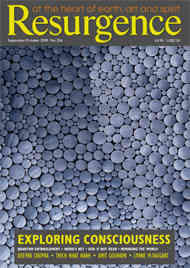The painter Ivon Hitchens dedicated his adult life to listening to the “subtlest nuances of the English landscape”. In all weathers throughout the year (or at least until Christmas, when he would retire to the relative warmth of his studio), he braved the elements and painted, notably, the six acres of woodland surrounding his home – an intensely private retreat – on the Sussex Downs. In increasingly broad, spontaneous, abstract brushstrokes, applied with well-deliberated abandon on canvas of markedly horizontal format, he described his impressions of subjects such as water, foliage and sky, a bracken-fringed path to a wood and a giant oak tree against a palpably greenish sky.
Peter Khoroche’s beautifully illustrated book sensitively charts Hitchens’ development as a painter of still lifes, nudes, flower studies and, above all, landscapes, the predominant subject of the last forty years of his life, following the purchase in 1939 of his Sussex retreat. Cézanne, Matisse and Braque were early liberating influences on his use of colour and design, and a 1925 a visit to paint alongside Ben and Winifred Nicholson at Banks Head, their Cumberland farmhouse, proved seminal. As Khoroche points out, “Both Ben Nicholson and Hitchens were still feeling their way towards a personal painting language. This meant unlearning much of what they had been taught at their art schools.” It was at Banks Head that Hitchens’ handling of paint started to become fresher, more dynamically assured and infused with a radiant new sense of light and ease.
Though Hitchens was friendly with the avant-garde “gentle nest of artists” (in the art critic Herbert Read’s phrase) residing in 1930s’ Hampstead – where he had a studio – he remained a quiet, rather solitary, independent artist, cautious and wary of cultural dogma and the noisily, if often necessarily assertive art politics of the time. A 1931 photo of a summer bathing party in Norfolk shows Hitchens alongside some of the most promising artists of the time: Henry Moore, Barbara Hepworth and Ben Nicholson. Whereas his companions are seen stripped partly bare in pursuit of pleasures of sun and sea, Hitchens himself appears a circumspect outsider, attired in jacket, jumper and tie, carrying a mackintosh over his arm. He resisted being stereotyped as any particular type of painter – an impressionist, or, latterly, some kind of abstract expressionist – saying “No artist should label himself. That is for others to do… A painter should have no rules or formulas.”
Setting up his canvas and paintbox in the open air, he sought “first to unravel the essential meaning of my subject, which is synonymous with its structure, and to understand my own psychological reactions to it”. He would then usually paint a quick sketch, followed by “a careful, well-knit design”, which he would then destroy, only to start all over again on the canvas, “painting freely, regardless of the literal proportions of forms”. He wrote elsewhere, “I should like things to fall into place with so clear a notation that the spectator’s eye and ‘aesthetic ear’ shall receive a clear message, a clear tune.”
It is the quite calligraphic clarity of his application of paint – a broad swathe of purplish black, say, to evoke a stretch of lake in the early morning, or a succession of broad brushstrokes (pinkish, russet and ochre) describing the cool, recessive depth of a woodland pathway in winter – that delivers in his paintings just the right note, “a clear tune”. The spectator of Hitchens’ landscapes feels absorbed in a sensuously intuitive appreciation of Nature, its enigmatic depths and silences, its thrilling fluctuations of light, tone and shadow, its swimming perspectives.
Hitchens’ best paintings conjure up with acute clarity the richly layered intricacies of a particular scene. For example, in a series of eight paintings of Warnford Water, a tree-fringed lake, he aimed to evoke, in different ways, “four entities, forming the whole subject”. These main themes were the lake itself (“swept by wind ripples and glaring light”); a “swift-flowing water race tumbling in a small fall” over a bank; “the deep, cool, clear trout pool below”; and “leading out from this pool, the winding stream, sand-banked, strung with waterweed”. The resulting, immensely varied group of pictures explores the conflict of visual interest between these four elements. Areas of canvas are left bare and white so that “the spectator’s eye can travel along these areas ‘from floe to floe’, over the picture surface instead of being engulfed…in a morass of paint…aping realism.” Through such startlingly subtle juxtapositions of subject, colour and weathered tone, each of these paintings conjures up its own wonderfully original atmosphere, its unique climate.







